Simply One of the Best CO2 Semi-auto Air Pistols in the World
Editors Note: Due to some unexpected weather the article I had planned for today has been delayed until next week. I began to think about new models from the last couple of years and if there was one CO2 pistol that stood out above all the others, and let me tell you, that is not a short list, but there is one favorite that certainly rises to the top of any list, the most personally enjoyable CO2 powered airgun that I own, the Umarex Model 712 Broomhandle Mauser. So, the following is a reprise of my original review of that gun from 2016. We’ll pick up with my original plan next week as we head into the 1-year anniversary of the Airgun Experience next Tuesday, May 30.
As you may recall, this tale of the Model 712 doesn’t begin in Germany but rather in the unlikely town of Anadarko, Oklahoma, some 25 years before the selective fire 1932 Model 712 Broomhandle was introduced. It’s 1907, about 12 years after Paul Mauser and his engineers developed the original Model 1896 or C96 Broomhandle.
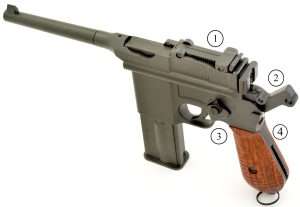
By the early 1900s, a slow but continual shift from traditional revolvers to new semiautomatic handguns was beginning to occur across the U.S. It began in Ogden, Utah, where firearms designer John Moses Browning, who had designed some of Winchester’s most famous rifles in the 1880s, Winchester’s first lever action shotgun in 1877, and their first pump action shotgun in 1893, patented a semi-auto pistol design for Fabrique Nationale (FN) in Belgium. This ingenious self loading pistol became the 7.65mm (.32 ACP) Model 1899-FN. It was followed a year later by the improved Model 1900-FN and at almost at the same time Browning reworked the design for the Colt’s Patent Firearms Mfg. Co., which introduced its first semi-auto in 1900, and we all know where that leads to by 1911. However, Browning wasn’t the only arms designer with a vision, and half a world away in Germany, Paul Mauser and his design department were about to invent one of the most historic semiautomatic pistols of all time, the Broomhandle.
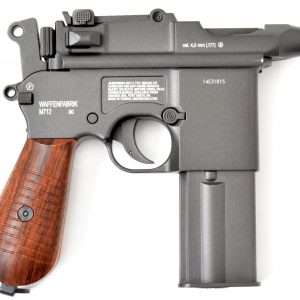
Between 1896 and the turn of the century the Broomhandle Mauser had already made such an impact in America that in 1899 the U.S. Army Board of Officers (Ordnance Department) began considering the adoption of self-loaders as a military issue sidearm. Tests were conducted through December and into February of 1900, which compared the 7.63mm Mauser Broomhandle, along with a 7.63mm Mannlicher self-loader (and a Model 1900 Borchardt-Luger tested in 1902-1903), all of which eventually lost out in trials to the new American made and John M. Browning-designed .38 Rimless Smokeless Colt’s Model 1900. Hundreds of the new Colt semi-auto models were purchased by the U.S. government for field trials (Model 1900 and improved Model 1902) but in the end, the U.S. Army Board of Officers stayed with revolvers as a standard issue sidearm until the .45 ACP Colt Model 1911 was introduced. Nevertheless, the Broomhandle Mauser left a lasting impression on America. By the very early 1900s the Broomhandle was being imported and sold in the U.S. through New York City retailer Von Lengerke & Detmold, which brought in 1,922 Broomhandle Mauser pistols between 1897 and 1905.
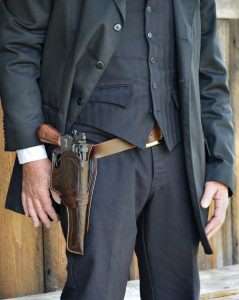
The Wild West and the Auto-Loader
There are numerous cases of early 20th century lawmen carrying not only traditional single actions but new Colt and S&W double actions, Colt’s .38 ACP Models 1900, 1902, and 1903 semi-autos, as well as imported guns like the FN 1900, Mauser and Luger P.08 Parabellum. There is photo evidence of this as well, including one Arizona lawman carrying a Luger in a Mexican-style drop loop holster, and the famous picture of that Sheriff from Anadarko Oklahoma Territory with his shoulder-stocked Broomhandle Mauser at the beginning of this article. That photograph was taken in the early 1900s by Annette Ross Hume who had arrived in Anadarko, O.T. around 1890. She had asked the Sheriff and his men to stack their weapons for her to photograph. The Broomhandle is right in the middle (between the grip and back of the magazine of the Umarex laying on top of the photo). Hume’s photographs of settlers, local Indians and the city of Anadarko began a series of images taken through 1910, though the majority of her work, now archived in the Phillips Collection of the University of Oklahoma Western History Collection, was done between 1901 and 1907.
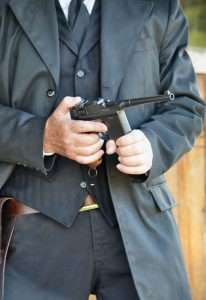
The Anadarko Sheriff who carried a 7.63mm Mauser Broomhandle was very likely James Thompson, who became Sheriff on February 5, 1902, after Anadarko’s first Sheriff, Frank Smith and his Deputy, George Beck, were killed in a January 15 shootout with the Casey Gang, eight miles west of Anadarko. The killings made headlines all across Oklahoma. Smith was fairly well known and had plenty of experience as a lawman having previously been a Deputy U.S. Marshal in the Western District at Ft. Smith, Arkansas (now home to Umarex, USA), and Sheriff of Cleveland County, Oklahoma Territory. Among those pursuing the killers were Deputy U.S. Marshal Warren Bennett and sheriffs from across Oklahoma, including James Thompson, who remained Caddo County Sheriff until 1904.
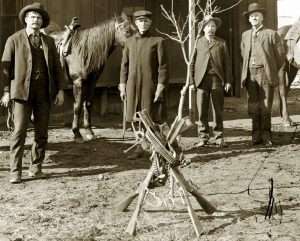
While there is no absolute certainty that Thompson is the Sheriff pictured in this article, according to the Caddo County, Oklahoma, Sheriffs Office, and the City of Anadarko Library historical archives, he is the most likely, as Broomhandle Mausers were readily available in the U.S. and the photo corresponds with the period when Annette Hume began doing much of her photography around Anadarko.
New York retailer Von Lengerke & Detmold continued to import various Mauser models (there were at least six early variations) until around 1910 and Mauser Broomhandles were also being distributed during this period through Browning Brothers in Ogden, Utah, (yes, that Browning), Iver Johnson, and through firearms stores in major U.S cities, thus it is likely that Oklahoma Sheriff John Thompson would have acquired his Broomhandle in the very early 1900s.
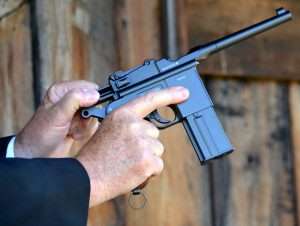
The Broomhandle Mauser and Umarex Model 712 Airgun
Aside from its 20th century role, the Broomhandle was also among the first and most innovative semi-auto pistols of the 19th century. Its origins date back to 1895 when Paul Mauser test fired the first example on March 15. The company, founded in 1871 by Paul (1838-1914) and his brother Wilhelm (1834-1882), was already one of the world’s most successful rifle makers by the 1890s.
The Umarex Legends Mauser Broomhandle Model 712 with selective fire is based on perhaps the most remarkable and desirable of all original Broomhandle designs. The original C96 and all subsequent versions, including the Model 712, used a locked-breech design with a rectangular bolt housed inside the square section of the barrel extension. Beneath the bolt, attached to the barrel extension, was the locking piece comprised of a steel block with a locking lug that engaged a slot in the lower surface of the bolt. Sometime in late 1896, the bolt and locking piece were modified to have two corresponding slots and lugs as shown on both the original Broomhandle in the photos and the Umarex Model 712. This design remained in use from 1896 to 1939.
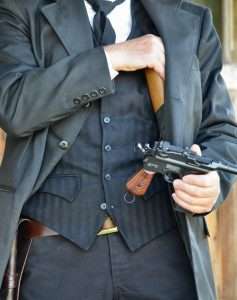
In operation, the locking piece was raised and lowered as it moved along an inclined plane milled into the frame. The bolt, locking block and barrel extension recoiled together for a distance of about 5mm (0.2-inch) before the locking piece began to descend the ramp. As it dropped, the bolt was unlocked and permitted to continue its rearward travel separated from the barrel extension, at which time the spent shell casing was ejected and the hammer re-cocked. The recoil spring powered the closing stroke of the mechanism, which stripped and chambered the next cartridge from the gun’s magazine box, and as the bolt and barrel extension closed, the locking piece was forced up into the locked position by the inclined plane. The Umarex Model 712 operates essentially the same way except there is no empty shell case to eject.
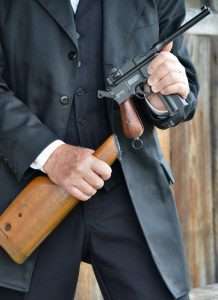
Among the Broomhandle’s many unprecedented features was a manual safety on the left rear of the frame actuated by pushing the lever upward into a notch, which either locked the hammer so that it could not be cocked, or if cocked, blocked the hammer’s forward movement. This is the original “cocked and locked.” There was also a wooden shoulder stock with a steel yoke that mounted into a channel cut into the gripstrap turning the Mauser into a carbine pistol. The hollow shoulder stock could also double as a holster that was carried in a leather shoulder harness.
Accurate Details and Operation
The Umarex is based on the 1932 Model 712 (also known as the Schnellfeuer), which was the first Mauser to employ a removable box magazine, as well as being fired either semi-auto or full-auto. Umarex has faithfully reproduced the Model 712 right down to the N R selective fire control switch on the left side of the frame, elevation adjustable rear sight, blowback bolt action and thumb safety operation. The Umarex is so exact in detail and dimensions that not only will an original (or reproduction) Mauser wooden shoulder stock holster mount on the back of the pistol grip; the gun will fit inside the shoulder stock holster with the magazine removed!
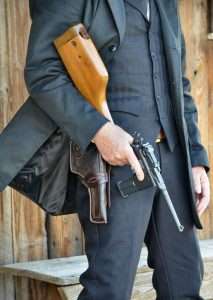
The original Broomhandle Mauser was a well-balanced gun with its center of gravity forward of the trigger to reduce muzzle jump. Recoil was more linear with the mass of the bolt slamming back over the hammer, and delivering its energy into the grip. As with all Broomhandle models the sharp recoil also drove the edges of the metal frame between the grips into the web of the shooter’s hand, which fortunately is not a problem with the Umarex airgun. Recoil from the CO2 driven bolt is brisk (especially on full auto) but not harsh like the centerfire models.
The Umarex Mauser 712 version, while lacking the lustrous blued finish of an original, has hit all of the key operating features, particularly for the Model 712, perhaps the most desirable of all Broomhandles because of its selective fire mechanism.
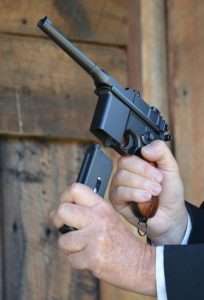
Up until the Model 712 the Broomhandle’s magazine was built integral with the frame, and there were three different cartridge capacities 6, 10, and 20 rounds. The standard barrel length was 5.5 inches and the guns were fitted with distinctive hardwood grips. The Umarex has a similar design to its detachable box magazine which holds both the CO2 and 18 steel BBs.
The M712 also has an accurately reproduced selective fire control switch on the left side of the frame with the correct N R markings, N for single action and R for full auto. Another original Mauser detail that Umarex has a properly reproduced is the elevation adjustable rear sight which is graduated out to 1000 meters; a wee bit optimistic even for the centerfire models.
As to the gun’s markings, it bears proper the WAFFENFABRIK name on the right side of the frame, and the correctly milled out side panel, just behind the magazine well, (usually left blank), is used for the airgun’s warning information. The Model 712 airguns also have serial numbers on the left side of the magazine well.
Loading and Firing
The Umarex Model 712 is no lightweight at 51 ounces including the box magazine, which weighs 15 ounces on its own. The magazine is loaded by removing the seating screw, inserting the CO2 cartridge, and threading the screw back into place with the supplied hex-head wrench until you hear the CO2 cartridge being pierced. The self-contained CO2 and BB magazine truly completes the authentic look of the Mauser 712. Loading BBs is just as efficient, using a follower that locks at the bottom allowing the BBs to be inserted through the loading port. You really need to have at least two or three of the magazines because you’ll burn through 18 shots with this airgun pretty fast.
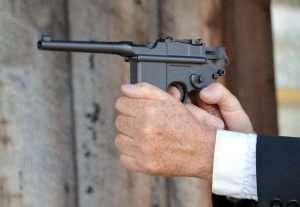
For the test I loaded up two magazines for a quick change. Also, when firing full auto you can go though a CO2 cartridge in about three reloads. The magazine release button located on the right side of the frame is easy to activate with the trigger finger, and the drop free magazines are quick to change out.
Before firing the first round, you pull the bolt to the rear, just like a real 7.63mm (or 9mm) Mauser Broomhandle; this also cocks the hammer, which can then be set to safe. The operation of the selector switch is also identical to the original; press the button in and rotate the lever from N to R, to switch from semi-auto to full auto, or back again to return to semi-auto. Trigger pull on the test gun averaged 4 pounds 11 ounces with quick take up and a clean break from shot to shot. In full auto you have to feather the trigger to get burst fire or you will empty the magazine in 1.5 seconds! Average velocity is 360 fps.
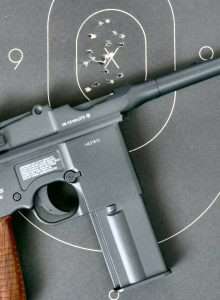
For the shooting evaluation I used Hornady Black Diamond anodized .177 caliber steel BBs. The optimum range for a blowback action air pistol is about 21 feet and the Mauser placed a best 10 shots at 2.25 inches. Fired on full auto, the accuracy opens up considerably, but at that point you really don’t care how many are in the X bull, you just want to load another magazine and listen to that blowback action sing. If I could only have one blowback action air pistol to my name, this would have to be it!
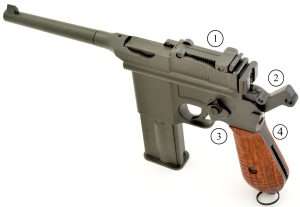

This was one of the airguns that got me hooked on airguns. The only fault is full auto and 18 rounds. would like to see an optional dual co2 40 round mag . Picked up a repro shoulder stock that pops right on . A great replica in select fire , and an affordable piece of select fire history .
“We’ll pick up with my original plan next week as we head into the 1-year anniversary of the Airgun Experience next Tuesday, March 30.” Don’t you mean, Tuesday, May 30?
After your original article was posted, I looked up some replica shoulder stocks. Without exception, the reviews of those stocks said some machining or a gun smith was required to get the stock to fit on either the Umarex C96 or M712. So where then can I find a replica stock that won’t require a gun smith or other machining to make it fit?
The shoulder stock I picked was on eBay , popped right on looks great
Dennis . Happy Anniversary and many more.
You remind me of the old Dan Fogelberg/Tim Weisberg album , yes album. Twin Sons of Different Mothers.
Hi Dennis and the group.
Yup, another one on my short list to acquire. I have the C96 which was fun to shoot until it broke. I tried to repair it my self, but no luck. It still makes a great wall hanger. Remember the Nazi’s in Raiders of the Lost Ark using them. What a cool looking weapon. Looking forward to your Anniversary Post. Thank you for a fun year. Also I liked your comment on this pistol being so much fun to shoot. At times we get so wrapped up in accuracy that we forget we can actually have some fun shooting these replicas.
Best Wishes
Harvey